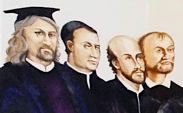Eustace White facts for kids
Quick facts for kids SaintEustace White |
|
|---|---|

Detail from a mural in the English Martyrs Parish in Derby. All martyrs who died on 10 December 1591. From left to right: Saints Swithun Wells, Edmund Gennings, Eustace White, and Polydore Plasden.
|
|
| Martyr | |
| Born | c. 1559 Louth, England |
| Died | 10 December 1591 (aged 31 - 32) Tyburn, London, England |
| Venerated in | Roman Catholic Church |
| Beatified | 15 December 1929 by Pope Pius XI |
| Canonized | 25 October 1970 by Pope Paul VI |
| Feast | 10 December (individual) 25 October (with the Forty Martyrs of England and Wales) 29 October (one of the Douai Martyrs) |
| Attributes | martyr's palm, noose in neck, crucifix |
Eustace White (1559 - 1591) was a Catholic priest. Due to his service, he was put on trial in December 1591 and subsequently hanged, drawn and quartered at Tyburn on 10 December 1591, along with another priest and three laymen. He is one of the Forty Martyrs of England and Wales and was canonised by Pope Paul VI in 1970.
Life
Born in Louth, Lincolnshire, in 1559, he converted to the Roman Catholic Church in 1584 and was disowned by his father. He travelled to Europe to study for the priesthood and was ordained, probably at the Venerable English College, Rome, in 1588. He returned to England for his ministry later that year - the year of the Spanish Armada. He thus began his ministry just as the anti-Catholic feeling was reaching fever pitch.
Martyrdom
A conversation with a fellow traveller led to his arrest in Dorset three years later in 1591. White put up a very articulate defence in the West Country, but was subsequently sent to London and imprisoned in Bridewell Prison. In October 1591 the Privy Council authorised the use of torture on White.
He was put on trial in December 1591 and subsequently hanged, drawn and quartered at Tyburn on 10 December 1591, along with another priest and three laymen.
Before being executed, he forgave Topcliffe his cruelties, and prayed for him, and at his execution, he told the people that his only treason was his priesthood, and thanked God for the happy crown to his labours. Being cut down alive, he rose to his feet, but was tripped up and dragged to the fire where two men stood upon his arms while the executioner butchered him.
Veneration
There is a stained glass window of Saint Eustace White in St. Mary's Catholic Church in Louth, where the martyr was born.
A book entitled Saint Eustace White: Elizabethan Priest and Martyr was written by Mark Vickers.

